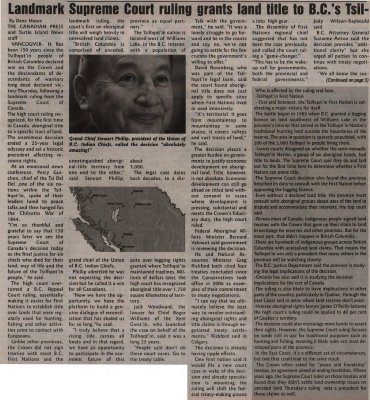"Landmark Supreme Court ruling grants land title to B.C.'s Tsilhqot'in, brings justice to chiefs lured and killed at faked peace talk"
- Publication
- Turtle Island News, 2 Jul 2014, pp.2-3
- Full Text
- Landmark Supreme Court ruling grants land title to B.C.'s Tsilhqot'in, brings justice to chiefs lured and killed at faked peace talkBy Dene Moore, THE CANADIAN PRESS and Turtle Island News Staff
VANCOUVER - It has been 150 years since the Tsilhqot'in people of British Columbia declared war on the Crown and the descendants of descendants of warriors long dead declared victory Thursday, following a landmark ruling from the Supreme Court of Canada.
The high court ruling recognized, for the first time in Canada, aboriginal title to a specific tract of land. The unanimous decision ended a 25-year legal odyssey and set a historic precedent affecting resource rights.
At an emotional news conference, Percy Guichon, chief of the Tsi Del Del, one of the six nations within the Tsilhqot'in, spoke of their leaders lured to peace talks and then hanged for the Chilcotin War of 1864.
"I'm so thankful and grateful to say that 150 years later we see the Supreme Court of Canada's decision today as the final justice for six chiefs who died for their land, way of life and the future of the Tsilhqot'in people," he said.
The high court overturned a B.C. Appeal Court ruling, essentially making it easier for First Nations to establish title over lands that were regularly used for hunting, fishing and other activities prior to contact with Europeans.
Unlike other provinces, the Crown did not sign treaties with most B.C. First nations and the landmark ruling, the court's first on aboriginal title, will weigh heavily in unresolved land claims.
"British Columbia is comprised of unceded, unextinguished aboriginal-title territory from one end to the other," said Stewart Phillip, grand chief of the Union of B.C. Indian Chiefs.
Phillip admitted he was not expecting the decision but he called it a win for all Canadians.
"Now we have the opportunity, we have the platform to build a genuine dialogue of reconciliation that has eluded us for so long," he said.
"I truly believe that a rising tide carries all boats and in that regard, we have an opportunity to participate in the economic future of this province as equal partners."
The Tsilhqont'in nations is located west of Williams Lake, in the B.C. Interior, with a population of about 3,000.
The legal case dates back decades, to a dispute over logging rights granted where Tsilhqot'in maintained traplines. Millions of dollars later, the high court has recognized aboriginal title over 1,750 square kilometres of territory.
Jack Woodward, the lawyer for Chief Roger Williams of the Xeni Gwet'in, who launched the case on behalf of the Tsilhqot'in, said it was a long 25 years.
"People said don't do these court cases. Go to the treaty table. Talk with the government," he said. "It was a lonely struggle to go forward and be in the courts and say, no, we're not going to settle for the few crumbs the government's willing to offer."
David Rosenburg, who was part of the Tsilhqot'in legal team, said the court found aboriginal title does not just apply to specific sites where First Nations lived or used intensively.
"It's territorial. It goes from mountaintop to mountaintop in some places; it covers valleys and vast tracts of land," he said.
The decision places a greater burden on governments to justify economic development on aboriginal land. Title, however, is not absolute. Economic development can still go ahead on titles land without consent in cases where development is pressing, substantial and meets the Crown's fiduciary duty, the high court ruled.
Federal Aboriginal Affairs Minister Bernard Valcourt said government is reviewing the decision.
He and Natural Resources Minister Greg Rickford both cited four treaties concluded since the Conservatives took office in 2006 as examples of their commitment to treaty negotiations.
"I can say that we ultimately believe the best way to resolve outstanding aboriginal rights and title claims is through negotiated treaty settlements," Rickford said in Calgary.
The decision is already having ripple effects.
One First nation said it would file a new court case in wake of the decision and already speculation is mounting the ruling will shift the federal treaty-making processes into high gear.
The Assembly of First Nations regional chief suggested that has not been the case previously, and called the court ruling a "game-changer."
"This has to be the wake up call for governments, both the provincial and federal governments," Jody Wilson-Raybould said.
B.C. Attorney General Suzanne Anton said the decision provides "additional clarity" but she urged all parties to continue with treaty negotiations.
"We all know the suc
(Continued on page 3)
Who is affected by the ruling and how.
- Tsilhqot'in First Nation
- First and foremost, the Tsilhqot'in First Nation is celebrating a major victory for itself.
- The battle began in 1983 when B.C. granted a logging licence on land southwest of Williams Lake in the province's Interior that served as the Tsilhqot'in Nation's traditional hunting land outside the boundaries of the reserve. The area in question is sparsely populated, with 200 of the 3,000 Tsilhqot'in people living there.
- Lower courts disagreed on whether the semi-nomadic Tsilhqot'in Nation, a group of six aboriginal bands, had title to the lands. The Supreme Court said they do and laid out for the first time how to determine whether a First Nation can prove title.
- The Supreme Court decision also found the province breached its duty to consult with the First Nation before approving the logging licence.
- Even without a declared land title, the province must consult with aboriginal groups about uses of the land in dispute and accommodate their interests, the top court said.
- Across most of Canada, indigenous people signed land treaties with the Crown that gave up their claim to land in exchange for reserves and other promises. But for the most part, that didn't happen in British Columbia.
- There are hundreds of indigenous groups across British Columbia with unresolved land claims. That means the Tsilhqot'in win sets a precedent that many others in the province will be watching closely.
- The B.C. Justice Department said the province is studying the legal implications of the decision.
- Ontario has also said it is studying the decision implications for the rest of Canada.
- The ruling is also likely to have implications in other parts of the country, particularly in Quebec, through the East Coast and in areas where land treaties don't exist.
- Veteran aboriginal rights lawyer James O'Reilly believes the high court's ruling could be applied to 40 percent of Quebec's territory.
- The decision could also encourage more bands to assert their rights. However, the Supreme Court's ruing focuses on lands still in use for traditional purposes such as hunting and fishing, meaning in likely rules out most developed parts of the province.
- In the East Coast, it's a different set of circumstances, but one that could lead to the same result.
- The Crown often asked for "peace and friendship" treaties, an agreement aimed at ending hostilities. Fifteen years ago, the Supreme Court ruled on those treaties and found that they didn't settle land ownership issues on unceded land. Thursday's ruling sets a precedent for those claims as well.
(Continued from page 2) cess that comes when we choose to negotiate rather than litigate," Anton said.The B.C. business community for decades has navigated the daunting landscape of the provinces few treaties, many land claims and hundreds of one-off provincial benefits agreements.
Greg D'Avignon, president of the Business Council of B.C., said the ruling provides greater certainty about the land base but it immediately spurred comment about projects like the Northern Gateway and Trans Mountain pipelines.
"The Supreme Court of Canada has made it clear that aboriginal title is very much like private property rights, at its core it is the right to decide what use is made of our land and waters," said acting Chief Clarence Innis of the Gitxaala, a nation that has launched legal action against the Enbridge pipeline.
Ontario Regional Chief Stan Beardy said the decision will have ramifications for major projects in his province, including the Ring of Fire and Energy East pipeline.
Nishnawbe Aski Nation says a landmark court decision will significantly impact development of the Ring of Fire.
NAN Grand Chief Harvey Yesno said the ruling sends a strong message that the government must recognize and respect Aboriginal title and deal honourably with First Nations.
"There's a number of First Nations that are in land claims negotiations," he said.
"I'm hoping it'll be a positive impact to settle or accelerate."
That includes the much-talked-about chromite-rich mining area known as the Ring of Fire, located in the James Bay Lowlands of northern Ontario.
Still, Ontario might need to do more than consult, as the Supreme Court decision places a greater burden on governments to get consent - or justify - development on Aboriginal land.
Chief Joe Alphonse, tribal chairman of Tsilhqot'in National Government, saw in the ruling the possibility of ending the crushing poverty of his people.
"Today, we can barely afford to have houses for our people," he said.
"We can barely afford to give our elders enough fuel money to go to Williams Lake to go see a doctor. A former tribal chief used to call our reserve a glorified concentration camp. I sure as hell hope we broke down some of those barriers today."
"There's no question that this ruling is creating, i think, a reason...to enhance the positions that First Nations have been taking," Yesno said.
Northern Development and mines minister Michael Gravelle said the province will review the ruling.
But he noted there's a significant difference between B.C. and Ontario because, unlike the Ring of Fire, the B.C. land in question doesn't fall under a treaty.
"Regardless, I certainly recognize - as does our government - how important it is to meet, if not exceed, our duty to consult, [and] work as closely as we can with our First Nations...and our Aboriginal peoples on all major projects."
- Creator
- Moore, Dene, Author
- Media Type
- Text
- Newspaper
- Item Type
- Clippings
- Publisher
- Turtle Island News
- Place of Publication
- Six Nations of the Grand River, ON
- Date of Publication
- 2 Jul 2014
- Date Of Event
- 26 Jun 2014
- Subject(s)
- Personal Name(s)
- Phillip, Stewart ; Guichon, Chief Percy ; Woodward, Jack ; Williams, Roger ; Rosenburg, David ; Valcourt, Bernard ; Rickford, Greg ; Wilson-Raybould, Jody ; Anton, Suzanne ; D'Avignon, Greg ; Innis, Chief Clarence ; Beardy, Stan ; Yesno, Chief Harvey ; Gravelle, Michael ; Alphonse, Chief Joe
- Corporate Name(s)
- Supreme Court of Canada ; Tsilhqot'in National Government ; British Columbia Court of Appeals ; Union of B.C. Indian Chiefs ; Business Council of B.C. ; Government of Canada ; Enbridge ; Government of British Columbia ; Gitxaala Nation Council ; Nishnawbe Aski Nation Council ; Assembly of First Nations.
- Local identifier
- SNPL004875v00d
- Language of Item
- English
- Geographic Coverage
-
-
British Columbia, Canada
Latitude: 52.14153 Longitude: -122.14451
-
- Creative Commons licence
 [more details]
[more details]- Copyright Statement
- Public domain: Copyright has expired according to Canadian law. No restrictions on use.
- Copyright Date
- 2014
- Copyright Holder
- Turtle Island News
- Contact
- Six Nations Public LibraryEmail:info@snpl.ca
Website:
Agency street/mail address:1679 Chiefswood Rd
PO Box 149
Ohsweken, ON N0A 1M0
519-445-2954



